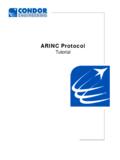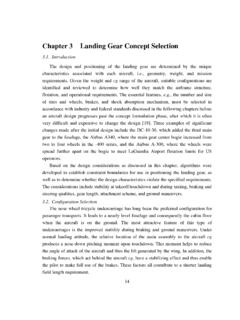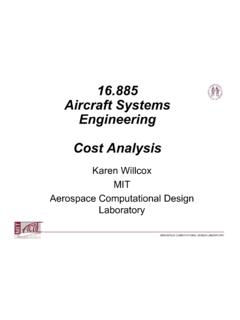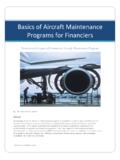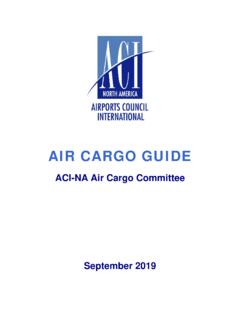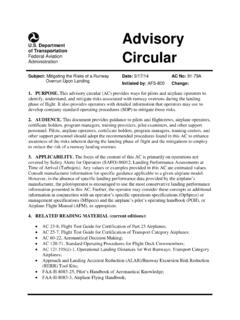Transcription of Elevator Design Chapter 12 Design of Control Surfaces
1 Elevator Design Chapter 12. Design of Control Surfaces From: Aircraft Design : A Systems Engineering Approach Mohammad Sadraey 792 pages September 2012, Hardcover Wiley Publications Introduction A very fundamental requirement of a safe flight is longitudinal Control ; which is assumed to be the primary function of an Elevator . An aircraft must be longitudinally controllable, as well as maneuverable within the flight envelope (Figure ). In a conventional aircraft, the longitudinal Control is primarily applied though the deflection of Elevator ( E), and engine throttle setting ( T). Longitudinal Control is governed through pitch rate . (Q) and consequently angular acceleration ( ) about y-axis (or rate of pitch rate). Longitudinal Control of an aircraft is achieved by providing an incremental lift force on horizontal tail.
2 Thus, Elevator which is classified as a primary Control surface is considered as a pitch Control device. The incremental tail lift can be generated by deflecting the entire tail or by deflecting Elevator which is located at the tail trailing edge. Since the horizontal tail is located at some distance from the aircraft center of gravity, the incremental lift force creates a pitching moment about the aircraft cg. Pitch Control can be achieved by changing the lift on either aft horizontal tail or canard. There are two groups of requirements in the aircraft longitudinal controllability: 1. Pilot force, 2. Aircraft response to the pilot input. In order to deflect the Elevator , the pilot must apply a force to stick/yoke/wheel and hold it (in the case of an aircraft with a stick- fixed Control system).
3 In an aircraft with a stick-free Control system, the pilot force is amplified through such devices as tab and spring. The pilot force analysis is out of scope of this text; the interested reader is referred to study references such as [11] and [12]. In a conventional symmetric aircraft, the longitudinal Control is not coupled with the lateral-directional Control . Thus, the Design of the Elevator is almost entirely independent of the Design of the aileron and the rudder. This issue simplifies the Design of the Elevator . In the Design of the Elevator , four parameters should be determined. They are: 1) Elevator planform area (SE), 2) Elevator chord (CE), 3) Elevator span (bE), and 4). maximum Elevator deflection ( Emax). As a general guidance, the typical values for these parameters are as follows: SE/Sh = to , bE/bh = , CE/Ch = , and 1.
4 Emax_up = -25 degrees, Emax_down = +20 degrees. Figure shows the geometry of the horizontal tail and Elevator . As a convention, the up deflection of Elevator is denoted negative, and down deflection as positive. Thus a, negative Elevator deflection is creating a negative horizontal tail list while generating a positive (nose up) pitching moment. - E. + E. Elevator Section A-A. Fuselage A. Horizontal tail Elevator CE. bE. A. Top-view of the horizontal tail and Elevator Figure Horizontal tail and Elevator geometry Prior to the Design of Elevator , the wing and horizontal tail must be designed, as well as the most aft and most forward locations of aircraft center of gravity must be known. In this section, principals of Elevator Design , Design procedure, governing equations, constraints, and Design steps as well as a fully solved example are presented.
5 Principles of Elevator Design Elevator is a primary Control surface placed on the trailing edge of the horizontal tail or canard. Longitudinal Control and longitudinal trim are two main functions of the Elevator ;. and it has minor influence on the longitudinal stability. Elevator is flap-like and is deflected up and down. With this deflection, the camber of the airfoil of the tail is changed, and consequently tail lift coefficient (CLh) is changed. The main objective of Elevator deflection is to increase or decrease tailplane lift and hence tailplane pitching moment. Factors affecting the Design of an Elevator are Elevator effectiveness, Elevator hinge moment, and Elevator aerodynamic and mass balancing. The Elevator effectiveness is a measure of how effective the Elevator deflection is in producing the desired pitching 2.
6 Moment. The Elevator effectiveness is a function of Elevator size and tail moment arm. Hinge moment is also important because it is the aerodynamic moment that must be overcome to rotate the Elevator . The hinge moment governs the magnitude of force required of the pilot to move the stick/yoke/wheel. Therefore, great care must be used in designing an Elevator so that the stick force is within acceptable limits for the pilots. Aerodynamic and mass balancing (See Section ) deal with technique to vary the hinge moment so that the stick force stays within an acceptable range; and no aero-elastic phenomenon occurs. The longitudinal Control handling qualities requirements during take-off operation is stated as follows: in an aircraft with a tricycle landing gear, the pitch rate should have a value such that the take-off rotation does not take longer than a specified length of time.
7 Since the take-off rotation dynamics is governed by Newton's second law, the take-off . rotation time may be readily expressed in terms of the aircraft angular acceleration ( ). about the main gear rotation point. For instance, in a transport aircraft, the acceptable value for the take-off rotation time is 3-5 seconds. The equivalent value for the angular rotation rate to achieve such requirement is 4-6 deg/sec2. This requirement must be satisfied when the aircraft center of gravity is located at the most forward location. Table provides take-off angular acceleration requirements for various types of aircraft. These specifications are employed in the Design of Elevator . In the Elevator detail Design process, the following parameters must be determined: 1.
8 Elevator -chord-to-tail-chord ratio (CE /Ch). 2. Elevator -span-to-tail-span ratio (bE /bh). 3. Maximum up Elevator deflection ( E ) max 4. Maximum down Elevator deflection ( E ) max 5. Aerodynamic balance of the Elevator 6. Mass balance of the Elevator The first four Elevator parameters (chord, span, and deflections) are interrelated. When the value of one Elevator parameter is increased, the value of other parameters could be decreased. On the other hand, each parameter has unique constraint. For instance, the Elevator maximum deflection should be less than the value that causes flow separation or causes the horizontal tail to stall. In addition, the ease of fabrication suggests to having an Elevator chord of span that is more convenient.
9 Thus, for simplicity in the Design and manufacture, the Elevator span is often selected to be equal to the horizontal tail span ( bE/bh = 1). 3. When Elevator is deflected more than about 20-25 degrees, flow separation over the tail tends to occur. Thus, the Elevator will lose its effectiveness. Furthermore, close to horizontal tail stall, even a small downward Elevator deflection can produce flow separation and loss of pitch Control effectiveness. To prevent pitch Control effectiveness, it is recommended to consider the Elevator maximum deflection to be less than 25. degrees (both up and down). Hence, the maximum Elevator deflection is dictated by the Elevator /tail stall requirement. No Aircraft Type mTO SE/Sh CE/Ch Emax (deg).
10 (kg) down up 1 Cessna 182 Light GA 1,406 22 25. 2 Cessna Citation III Business jet 9,979 15 3 Gulfstream 200 Business jet 16,080 20 4 AT-802 Agriculture 7,257 15 29. 5 ATR 42-320 Regional 18,600 16 26. airliner 6 Lockheed C-130 Military cargo 70,305 15 40. Hercules 7 Fokker F-28-4000 transport 33,000 15 25. 8 Fokker F-100B Airliner 44,450 22 25. 9 McDonnell Douglas DC- transport 140,600 10 25. 8. 10 McDonnell Douglas DC- transport 51,700 15 25. 9-40. 11 McDonnell Douglas DC- transport 251,700 27. 10-40. 12 McDonnell Douglas transport 273,300 20 MD-11. 13 boeing 727-100 transport 76,820 16 26. 14 boeing 737-100 transport 50,300 20 20. 15 boeing 777-200 transport 247,200 25 30. 16 boeing 747-200 transport 377,842 17 22. 17 Airbus A-300B transport 165,000 - - 18 Airbus 320 transport 78,000 17 30.
